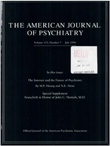Is dysthymia a different disorder in the elderly?
Abstract
OBJECTIVE: This study evaluated elderly dysthymic patients in a late life depression clinic and compared their clinical features to previous findings in young adult dysthymic patients. METHOD: Of 224 consecutive elderly outpatients, 40 (17.9%) met criteria for dysthymic disorder. A semistructured interview was used to obtain history, the Structured Clinical Interview for DSM-III-R--Patient Version and the Structured Clinical Interview for DSM-III-R Personality Disorders were used to make DSM-III-R diagnoses, and standard rating instruments for depression were administered. RESULTS: The gender distribution was equal and major stressors were common. The mean age at onset of dysthymia was 55.2 years (SD = 15.4), with an average illness duration of 12.5 years (SD = 14.2). Early onset (before 21 years of age) and secondary dysthymia were rare. A history of major depression earlier during the course of dysthymic illness, comorbid anxiety disorders, and personality disorders were relatively uncommon. Cross-sectionally, cognitive and functional symptoms were more prominent than vegetative symptoms. CONCLUSIONS: Dysthymia is not uncommon among depressed elderly outpatients who present for treatment. Elderly dysthymic patients differ from young adult dysthymic patients, who are mostly female with an early onset and who frequently have comorbid axis I and axis II disorders. Most elderly dysthymic patients do not appear to be young dysthymic patients who simply grew older, and the DSM-III-R subtyping of dysthymia into early/late onset and primary/secondary may not apply to the elderly. Further clinical studies of "pure" dysthymic disorder appear feasible in the elderly, and these are clearly needed.
Access content
To read the fulltext, please use one of the options below to sign in or purchase access.- Personal login
- Institutional Login
- Sign in via OpenAthens
- Register for access
-
Please login/register if you wish to pair your device and check access availability.
Not a subscriber?
PsychiatryOnline subscription options offer access to the DSM-5 library, books, journals, CME, and patient resources. This all-in-one virtual library provides psychiatrists and mental health professionals with key resources for diagnosis, treatment, research, and professional development.
Need more help? PsychiatryOnline Customer Service may be reached by emailing [email protected] or by calling 800-368-5777 (in the U.S.) or 703-907-7322 (outside the U.S.).



